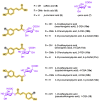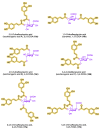Risk Assessment of Chlorogenic and Isochlorogenic Acids in Coffee By-Products
- PMID: 37513412
- PMCID: PMC10385244
- DOI: 10.3390/molecules28145540
Risk Assessment of Chlorogenic and Isochlorogenic Acids in Coffee By-Products
Abstract
Chlorogenic and isochlorogenic acids are naturally occurring antioxidant dietary polyphenolic compounds found in high concentrations in plants, fruits, vegetables, coffee, and coffee by-products. The objective of this review was to assess the potential health risks associated with the oral consumption of coffee by-products containing chlorogenic and isochlorogenic acids, considering both acute and chronic exposure. An electronic literature search was conducted, revealing that 5-caffeoylquinic acid (5-CQA) and 3,5-dicaffeoylquinic acid (3,5-DCQA) are the major chlorogenic acids found in coffee by-products. Toxicological, pharmacokinetic, and clinical data from animal and human studies were available for the assessment, which indicated no significant evidence of toxic or adverse effects following acute oral exposure. The current state of knowledge suggests that long-term exposure to chlorogenic and isochlorogenic acids by daily consumption does not appear to pose a risk to human health when observed at doses within the normal range of dietary exposure. As a result, the intake of CQAs from coffee by-products can be considered reasonably safe.
Keywords: CQA; caffeic acid; caffeoylquinic acid; chlorogenic acid; coffee by-products; dicaffeoylquinic acid; novel foods; quinic acid; risk assessment; toxicology.
Conflict of interest statement
S.S. is the owner of Coffee Consulate, Mannheim, Germany. Coffee Consulate is an independent training and research center. Coffee Consulate is currently researching the potential of coffee by-products. However, S.S. reports that there is no conflict of interest related to the work under consideration. The other authors declare that they have no conflict of interest.
Figures










Similar articles
-
[Molecular docking of chlorogenic acid, 3,4-di-O-caffeoylquinic acid and 3,5-di-O-caffeoylquinic acid with human serum albumin].Zhong Xi Yi Jie He Xue Bao. 2012 Oct;10(10):1149-54. doi: 10.3736/jcim20121012. Zhong Xi Yi Jie He Xue Bao. 2012. PMID: 23073199 Chinese.
-
Role of degradation products of chlorogenic acid in the antioxidant activity of roasted coffee.J Agric Food Chem. 2015 Feb 25;63(7):1996-2005. doi: 10.1021/jf5060563. Epub 2015 Feb 16. J Agric Food Chem. 2015. PMID: 25658375
-
Chlorogenic acids from green coffee extract are highly bioavailable in humans.J Nutr. 2008 Dec;138(12):2309-15. doi: 10.3945/jn.108.095554. J Nutr. 2008. PMID: 19022950
-
Coffee Chlorogenic Acids Incorporation for Bioactivity Enhancement of Foods: A Review.Molecules. 2022 May 25;27(11):3400. doi: 10.3390/molecules27113400. Molecules. 2022. PMID: 35684338 Free PMC article. Review.
-
Bioavailability and metabolism of chlorogenic acids (acyl-quinic acids) in humans.Compr Rev Food Sci Food Saf. 2020 Jul;19(4):1299-1352. doi: 10.1111/1541-4337.12518. Epub 2020 Jan 3. Compr Rev Food Sci Food Saf. 2020. PMID: 33337099 Review.
Cited by
-
Potential Antioxidant and Anti-Inflammatory Properties of Polyphenolic Compounds from Cirsium japonicum Extract.Int J Mol Sci. 2024 Jan 8;25(2):785. doi: 10.3390/ijms25020785. Int J Mol Sci. 2024. PMID: 38255858 Free PMC article.
-
Research Progress Regarding the Effect and Mechanism of Dietary Polyphenols in Liver Fibrosis.Molecules. 2023 Dec 25;29(1):127. doi: 10.3390/molecules29010127. Molecules. 2023. PMID: 38202710 Free PMC article. Review.
-
The Antimicrobial Effects of Coffee and By-Products and Their Potential Applications in Healthcare and Agricultural Sectors: A State-of-Art Review.Microorganisms. 2025 Jan 21;13(2):215. doi: 10.3390/microorganisms13020215. Microorganisms. 2025. PMID: 40005582 Free PMC article. Review.
-
Genotoxicity of Coffee, Coffee By-Products, and Coffee Bioactive Compounds: Contradictory Evidence from In Vitro Studies.Toxics. 2025 May 18;13(5):409. doi: 10.3390/toxics13050409. Toxics. 2025. PMID: 40423488 Free PMC article. Review.
-
Food Safety Assessment and Nutraceutical Outcomes of Dairy By-Products: Ovine Milk Whey as Wound Repair Enhancer on Injured Human Primary Gingival Fibroblasts.Foods. 2024 Feb 23;13(5):683. doi: 10.3390/foods13050683. Foods. 2024. PMID: 38472796 Free PMC article.
References
-
- Lachenmeier D.W., Teipel J., Scharinger A., Kuballa T., Walch S.G., Grosch F., Brunzel M., Okaru A.O., Schwarz S. Fully automated identification of coffee species and simultaneous quantification of furfuryl alcohol using NMR spectroscopy. J. AOAC Int. 2020;103:306–314. doi: 10.1093/jaocint/qsz020. - DOI - PubMed
-
- Rimbach G., Nagursky J., Erbersdobler H.F. Lebensmittel-Warenkunde für Einsteiger. 2nd ed. Springer; Berlin, Germany: 2015.
-
- Rösemann U. Coffea—Für viele müde Menschen die erste Pflanze des Tages. Biol. Unserer Zeit. 2017;47:336–337. doi: 10.1002/biuz.201770521. - DOI
-
- Hegnauer R. Chemotaxonomie der Pflanzen: Eine Übersicht über die Verbreitung und die Systematische Bedeutung der Pflanzenstoffe. Birkhäuser; Basel, Switerland: 1973. p. 169. Band 21.
Publication types
MeSH terms
Substances
LinkOut - more resources
Full Text Sources
Research Materials

